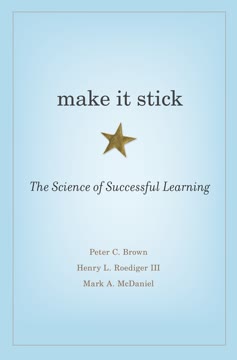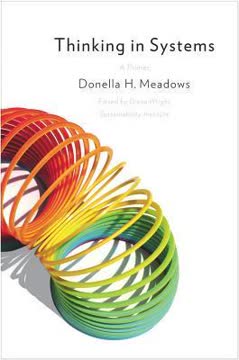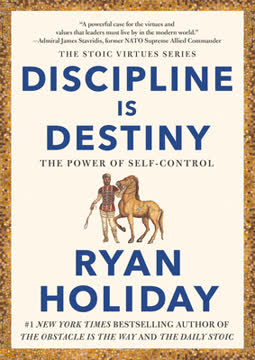نکات کلیدی
1. تکامل معنا: سفری مادامالعمر در توسعه فردی
"توسعه در هر دورهای از تاریخ زندگی، که شامل خروج از یک حالت تکاملی روانزیستی است، باید شامل خروج از درگیری در یک زمینه انسانی خاص نیز باشد."
فرآیند مادامالعمر. تکامل معنا محدود به دوران کودکی نیست بلکه در طول زندگی ما ادامه دارد. این شامل یک سری تغییرات کیفی در نحوه ساختن درک ما از خود و جهان اطرافمان است.
مراحل توسعه. این تکامل از طریق مراحل مشخصی پیشرفت میکند که هر کدام با یک روش منحصر به فرد در سازماندهی تجربه مشخص میشود:
- جذبکننده (نوزادی)
- تکانشی (اوایل کودکی)
- امپریالی (کودکی میانه)
- بینفردی (نوجوانی)
- نهادی (اوایل بزرگسالی)
- بینفردی (بزرگسالی بالغ)
تعادل و رشد. هر مرحله نمایانگر یک تعادل موقت یا "آتشبس تکاملی" بین خود و محیط است. رشد زمانی رخ میدهد که این تعادل به چالش کشیده شود و به یک روش پیچیدهتر و جامعتر برای ساختن معنا منجر شود.
2. تعادل موضوع-شیء: هسته رشد روانشناختی
"به نظر میرسد هر توسعهای نیاز به فرهنگ خود دارد؛ هر بازنگری قرارداد تکاملی به نظر میرسد نیاز به پلی از آن فرهنگ به یک فرهنگ جدید دارد که به نوعی جدید، بخشی از آن میشود."
تغییر بنیادی. هسته رشد روانشناختی در بازنگری مداوم آنچه ما به عنوان "موضوع" (آنچه در آن درگیر هستیم و نمیتوانیم بر آن تأمل کنیم) و آنچه به عنوان "شیء" (آنچه میتوانیم بر آن دیدگاه بگیریم و تأمل کنیم) میپذیریم، نهفته است.
افزایش پیچیدگی. با توسعه، ما قادر میشویم آنچه قبلاً موضوع بود را به عنوان شیء بپذیریم:
- حرکت از بودن به عنوان امیال به داشتن امیال
- حرکت از بودن به عنوان روابط به داشتن روابط
- حرکت از بودن به عنوان هویت به داشتن هویت
گسترش آگاهی. این فرآیند امکان درکهای پیچیدهتر و دقیقتر از خود و دیگران را فراهم میکند و به خودمختاری، صمیمیت و یکپارچگی بیشتر منجر میشود.
3. فرهنگهای درگیری: زمینههای اجتماعی توسعه
"هرگز 'فقط یک فرد' وجود ندارد؛ خود کلمه فقط به آن جنبه از شخص اشاره دارد که فردیت یافته است، جنبه تمایز."
محیطهای نگهدارنده. در طول زندگی، ما در انواع مختلفی از "فرهنگهای درگیری" نگهداری میشویم - زمینههای اجتماعی که هم از روش فعلی ما در ساختن معنا حمایت میکنند و هم آن را به چالش میکشند.
وظایف کلیدی. این فرهنگها سه وظیفه اساسی را انجام میدهند:
- نگهداشتن: تأیید و حمایت از تعادل تکاملی فعلی
- رها کردن: تناقض و به چالش کشیدن تعادل فعلی
- باقی ماندن: فراهم کردن تداوم در طول انتقالها
زمینههای در حال تکامل. با توسعه، ماهیت این محیطهای نگهدارنده تغییر میکند:
- مادرانه (نوزادی)
- خانواده (اوایل کودکی)
- مدرسه و گروههای همسالان (کودکی میانه)
- روابط عاشقانه (نوجوانی)
- کار و جوامع ایدئولوژیک (بزرگسالی)
- شراکتهای صمیمی (بزرگسالی بالغ)
4. خود تکانشی: پیمایش انتقالهای اوایل کودکی
"کودک به تدریج از بودن به عنوان موضوع به واکنشها، حرکات و احساسات خود، به داشتن واکنشها، حرکات و احساسات خود حرکت میکند."
استقلال در حال ظهور. مرحله تکانشی نشاندهنده اولین گامهای کودک به سوی استقلال روانشناختی است، زیرا آنها شروع به تمایز امیال و ادراکات خود از دیگران میکنند.
توسعههای کلیدی:
- پایداری شیء: درک اینکه اشیاء وقتی از دید خارج میشوند همچنان وجود دارند
- جدایی-فردیت: شناخت خود به عنوان جدا از مراقبان
- بازی تخیلی: استفاده از تخیل برای کاوش و درک جهان
چالشها و حمایتها. این مرحله میتواند با قشقرقها و رفتارهای مخالفانه مشخص شود زیرا کودک خودیت در حال ظهور خود را ابراز میکند. مراقبان حمایتی فراهم میکنند:
- مرزها و محدودیتهای واضح
- فرصتهایی برای کاوش ایمن
- تنظیم و هماهنگی عاطفی
5. خود امپریالی: تسلط بر دنیای قوانین و نقشها
"کودک خودکفا و متمرکز بر شایستگی، نتیجه تعادلی است که امیدها و آرزوهای مرکزی آن درباره خود است."
خودکفایی. مرحله امپریالی با تمرکز بر نیازها، علایق و شایستگیهای شخصی مشخص میشود. کودک به طور فزایندهای قادر به پیمایش دنیای قوانین و نقشها میشود.
توسعههای کلیدی:
- عملیات عینی: تفکر منطقی درباره اشیاء و موقعیتهای ملموس
- نقشپذیری: درک دیدگاههای دیگران، هرچند به صورت محدود
- مفهوم خود: توسعه یک حس پایدارتر از خود در طول زمان و موقعیتها
دنیای اجتماعی. خود امپریالی در محیطهایی که فراهم میکنند رشد میکند:
- انتظارات و پیامدهای واضح
- فرصتهایی برای تسلط و دستاورد
- شناخت تلاشها و دستاوردهای فردی
6. خود بینفردی: پذیرش متقابل و روابط
"تعادل بینفردی نوعی خودکفایی را نشان میدهد که در سطحی کاملاً جدید از پیچیدگی، ما را به یاد همتای تکاملی آن، تعادل امپریالی کودک مدرسهای میاندازد."
تمرکز رابطهای. مرحله بینفردی نشاندهنده تغییری به سوی تعریف خود از طریق روابط و درک متقابل با دیگران است.
توسعههای کلیدی:
- تفکر انتزاعی: توانایی استدلال درباره موقعیتهای فرضی
- نقشپذیری متقابل: هماهنگی دیدگاههای متعدد به طور همزمان
- استانداردهای درونی: توسعه حس درست و غلط بر اساس انتظارات اجتماعی
چالشها و حمایتها. این مرحله میتواند شامل:
- روابط و درگیریهای شدید همسالان
- مبارزات با هویت و تعلق
- نیاز به تأیید و پذیرش از دیگران
محیطهای حمایتی فراهم میکنند:
- فرصتهایی برای روابط معنادار
- راهنمایی در پیمایش پیچیدگیهای اجتماعی
- تأیید احساسات و تجربیات
7. خود نهادی: ایجاد هویت و خودمختاری
"تعادل نهادی، که خود را به عنوان یک فرم به وجود میآورد، تجلی شناختی خود را در توسعه کامل سیستم عملیات رسمی که پیاژه توصیف میکند، دارد."
خودنویسی. مرحله نهادی شامل توسعه یک هویت منسجم و سیستم ارزشی مستقل از انتظارات دیگران است.
توسعههای کلیدی:
- تفکر ایدئولوژیک: توسعه باورها و ارزشهای شخصی
- خودتنظیمی: توانایی مدیریت احساسات و رفتار در پیگیری اهداف بلندمدت
- تمرکز شغلی: ایجاد خود در کار و نقشهای بزرگسالی
چالشها و حمایتها. این مرحله میتواند شامل:
- مبارزات با تعهد و هدف
- تعادل اهداف شخصی با انتظارات اجتماعی
- ایجاد روابط صمیمی در حالی که خودمختاری را حفظ میکند
محیطهای حمایتی فراهم میکنند:
- فرصتهایی برای رهبری و مسئولیت
- راهنمایی و مشاوره در توسعه شغلی
- فضایی برای کاوش و پالایش ارزشهای شخصی
8. خود بینفردی: دستیابی به صمیمیت واقعی و یکپارچگی
"ترانسندنس از استبداد فرم—موضوعی که این فصل با آن آغاز شد—ممکن است به لحاظ شناختی در قالب تفکر دیالکتیکی، یا به لحاظ اجتماعی-اخلاقی در قالب ساختار پسایدئولوژیک، خود را نشان دهد، اما به نظر میرسد که به طور مرکزی در عرصه وسیعتر خود روانشناختی به ظرفیت برای صمیمیت واقعی میرسد."
یکپارچگی و صمیمیت. مرحله بینفردی نمایانگر بالاترین سطح توسعه بزرگسالی است که با توانایی یکپارچهسازی دیدگاههای متعدد و دستیابی به صمیمیت واقعی مشخص میشود.
توسعههای کلیدی:
- تفکر دیالکتیکی: نگهداشتن و یکپارچهسازی ایدههای به ظاهر متناقض
- خودتحولی: تمایل به تغییر و رشد از طریق روابط
- همدلی جهانی: گسترش مراقبت و درک فراتر از دایره نزدیک خود
دستیابی نادر. این مرحله نسبتاً نادر است و نیازمند:
- رشد شخصی مداوم و خوداندیشی
- تمایل به پذیرش آسیبپذیری و عدم قطعیت
- روابط و محیطهای حمایتی که توسعه مداوم را تشویق میکنند
9. درمان طبیعی: حمایت از توسعه سالم در طول زندگی
"به نظر میرسد نظریه توسعهای نوعی مشاوره مشابه برای تلاش به کمک روانشناختی به افراد دارد. به جای اینکه عمل رواندرمانی را معیار همه ملاحظات کمک قرار دهیم، ابتدا به معنای و ساختار آن نمونههای 'درمان' ناخودآگاه نگاه کنید که بارها و بارها در طبیعت رخ میدهند."
حمایتهای طبیعی. مؤثرترین حمایت روانشناختی اغلب از محیطهای نگهدارنده طبیعی که در طول زندگی با آنها مواجه میشویم، به جای درمان رسمی میآید.
عناصر کلیدی درمان طبیعی:
- شناخت و تأیید تعادل تکاملی فعلی فرد
- چالش و تناقض ملایم برای ترویج رشد
- تداوم و ثبات در دورههای انتقال
پیامدهای حرفهای. متخصصان سلامت روان میتوانند با:
- درک نیازهای توسعهای در هر مرحله
- تکرار وظایف محیطهای نگهدارنده طبیعی
- حمایت از فرآیند تکاملی فرد به جای تحمیل اهداف خارجی
اهمیت اجتماعی. ایجاد جوامع و نهادهایی که این وظایف درمانی طبیعی را فراهم میکنند برای ترویج توسعه سالم و جلوگیری از ناراحتی روانشناختی در مقیاس وسیعتر حیاتی است.
آخرین بهروزرسانی::
FAQ
What's The Evolving Self about?
- Focus on Human Development: The Evolving Self by Robert Kegan delves into the evolution of meaning-making in human development, focusing on how individuals construct their identities and navigate relationships.
- Stages of Development: Kegan outlines several stages of self-evolution, including Impulsive, Imperial, Interpersonal, Institutional, and Interindividual Balances, each representing a different understanding of self and others.
- Integration of Theories: The book integrates insights from developmental psychology, particularly those of Jean Piaget and Lawrence Kohlberg, to provide a comprehensive framework for understanding personality development.
- Cultural Context: It also discusses how cultural environments influence personal development, highlighting the importance of supportive relationships and contexts that facilitate growth.
Why should I read The Evolving Self?
- Deep Understanding of Self: Reading this book will enhance your understanding of how personal identity evolves and how individuals relate to their environments and others.
- Practical Applications: Kegan’s insights are applicable to various fields, including psychology, education, and personal development, making it valuable for professionals and lay readers alike.
- Framework for Growth: The book offers a framework for recognizing and navigating personal growth and the complexities of human relationships, which can be beneficial in both personal and professional contexts.
- Insight into Relationships: It provides valuable insights into the complexities of personal development and how relationships impact growth, helping readers navigate interpersonal dynamics more effectively.
What are the key takeaways of The Evolving Self?
- Evolutionary Truces: Kegan introduces "evolutionary truces," temporary balances individuals achieve as they navigate their development, highlighting the ongoing nature of personal evolution.
- Interconnectedness of Self and Other: Understanding oneself is intrinsically linked to understanding others, as identities are shaped through relationships and social contexts.
- Lifelong Process: Personal development is portrayed as a lifelong process of differentiation and integration, where individuals continuously negotiate their identities in relation to their environments.
- Importance of Holding Environments: Kegan emphasizes the need for supportive "holding environments" that recognize and nurture individuals as they transition between developmental stages.
What are the best quotes from The Evolving Self and what do they mean?
- “The spirit is never at rest but always engaged in ever progressive motion.”: Reflects Kegan's view that human development is a dynamic process, constantly evolving as individuals encounter new experiences and challenges.
- “What is self and what is other may be a question of the person’s biology, but it is equally a question of the person’s philosophy.”: Highlights the interplay between biological and philosophical understandings of identity, suggesting that our self-concept is shaped by both innate factors and personal beliefs.
- “Without contraries, there is no progression.”: Underscores the importance of conflict and tension in personal growth, indicating that challenges and oppositions are essential for development.
- "All breakdown is not pathological; some breakdown is breakthrough.": Suggests that moments of crisis can lead to significant personal growth and transformation, rather than just being seen as failures.
What are the stages of self-evolution described in The Evolving Self?
- Impulsive Balance (Stage 1): Individuals are embedded in their impulses and perceptions, lacking the ability to differentiate between self and other, with an immediate and self-centered understanding of the world.
- Imperial Balance (Stage 2): Individuals begin to assert their independence and develop a more self-contained sense of self, recognizing their needs but struggling with empathy and understanding others' perspectives.
- Interpersonal Balance (Stage 3): Focuses on relationships, where individuals derive their sense of self from interactions with others, but may struggle with maintaining their own identity amidst relational demands.
- Institutional Balance (Stage 4): Emphasizes self-authorship and the ability to navigate complex social systems while maintaining a sense of personal identity.
How does Kegan define "evolutionary truces" in The Evolving Self?
- Temporary Balances: "Evolutionary truces" are temporary resolutions individuals achieve as they navigate their development, balancing their needs for inclusion and autonomy.
- Dynamic Process: These truces are not static; they represent ongoing negotiations between self and other, where individuals continuously adapt their identities in response to changing circumstances.
- Foundation for Growth: Each evolutionary truce sets the stage for future growth, as individuals must eventually renegotiate their balances to accommodate new experiences and insights.
What role does Jean Piaget play in The Evolving Self?
- Influential Theorist: Kegan credits Jean Piaget as a significant influence on his understanding of human development, particularly in terms of cognitive and moral development.
- Stages of Cognitive Development: Piaget's stages provide a framework for Kegan's exploration of how individuals construct meaning and navigate their identities throughout life.
- Integration of Ideas: Kegan builds upon Piaget's work to propose a more comprehensive view of development that includes emotional and social dimensions, emphasizing the interconnectedness of cognitive and affective processes.
How does Kegan's view of moral development differ from traditional theories?
- Beyond Cognitive Focus: While traditional theories often emphasize cognitive aspects, Kegan integrates emotional and relational dimensions, highlighting the importance of interpersonal relationships in shaping moral understanding.
- Evolutionary Perspective: Moral development is part of the broader process of personal evolution, where individuals continuously negotiate their moral beliefs in relation to their experiences and social contexts.
- Stages of Moral Meaning-Making: He outlines stages of moral meaning-making that parallel his stages of self-evolution, emphasizing the dynamic interplay between individual and societal values.
What is the significance of the "interindividual balance" in Kegan's framework?
- New Level of Integration: The interindividual balance represents a stage where individuals can reflect on their own identities while also recognizing and valuing the identities of others, fostering deeper connections and mutual understanding.
- Community and Individuality: This stage allows for a more nuanced understanding of community, where individuals are seen as unique yet interconnected, promoting a sense of belonging without sacrificing individuality.
- Foundation for Intimacy: It is crucial for developing intimate relationships, enabling individuals to share their true selves while respecting the distinctness of others.
How does The Evolving Self address the challenges of modern relationships?
- Navigating Complexity: Kegan's framework helps individuals understand the complexities of modern relationships by emphasizing the importance of self-awareness and mutual understanding in navigating interpersonal dynamics.
- Balancing Inclusion and Autonomy: The book highlights the ongoing tension between the yearnings for inclusion and autonomy, providing insights into how individuals can maintain healthy relationships while also honoring their own needs.
- Encouraging Growth: Kegan encourages readers to view challenges in relationships as opportunities for growth, emphasizing that personal evolution is a continuous process that can enhance both individual and relational well-being.
What practical advice does Kegan offer for personal development in The Evolving Self?
- Embrace Evolution: Kegan advises readers to embrace the ongoing process of personal evolution, recognizing that growth involves both differentiation and integration throughout life.
- Cultivate Self-Awareness: He emphasizes the importance of self-awareness in understanding one's own meaning-making processes and how they influence relationships with others.
- Foster Open Communication: Kegan encourages open communication in relationships, advocating for the sharing of feelings and experiences as a means of fostering deeper connections and mutual understanding.
نقد و بررسی
کتاب خود در حال تحول نوشتهی رابرت کیگان به خاطر بررسی عمیق و بینشمندانهاش در زمینهی توسعهی روانشناختی انسان بسیار مورد توجه قرار گرفته است. خوانندگان به چارچوب پنج مرحلهای کیگان برای درک ساخت معنا و رشد شخصی در طول زندگی ارج مینهند. در حالی که برخی نوشتار پیچیدهی آن را چالشبرانگیز میدانند، بسیاری آن را خواندنی عمیق و تحولآفرین تلقی میکنند. تمرکز کتاب بر رابطهی در حال تحول بین خود و دیگران با خوانندگان ارتباط برقرار میکند و دیدگاههای ارزشمندی در زمینهی توسعهی شخصی، درمان و طبیعت انسانی ارائه میدهد. با وجود پیچیدگیهایش، بیشتر منتقدان تلاش برای درک آن را به خاطر بینشهای عمیقش ارزشمند میدانند.
Similar Books














